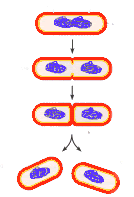Genetic variation
Random mutations
Vertical transmission
Horizontal transmission
The F factor
Irresponsible use of antibiotics
Genetic – why?
All of the characteristics of bacterial organisms are a result of the blueprint for the various proteins coded in their DNA, the same DNA that all life has on Earth (except for the specific base sequence). Genetic simply means arising from DNA.
Variation – bacteria have variation?
Who would have thought? I mean, I always thought they were just a bunch of tiny hot dogs without the sausage in the middle, hanging around causing trouble. Well, I found out, no, they’re not hot dogs. They’re beautiful organisms in their own right, and if it wasn’t for our inherent bias of being on the receiving end of their infection, they wouldn’t be baddies. They could be heroes. In fact, some of them are heroes! Some bacteria do contribute positively to our life. The undeniable evidence for that is pickles.
(1+2) So, the variation is genetic.
Bacteria – why bacteria?
Due to bacteria being a common cause of disease, as well as their fast life cycle, they are a good case study for explaining selection and resistance. This is done in the light of antibiotic resistance. Things are complicated on Earth; in the Antibiotics topic I point out that antibiotics literally murder bacteria in a very efficient way. What could go wrong?
As generations of bacteria come to life, their DNA doesn’t stay completely identical. Random mutations sometimes arise. Mutations are changes in DNA which result in different characteristics. No, not bacteria with fangs, but subtle changes in, say, the shape of a certain protein which sits on the cell wall. These mutations and the bacteria don’t “know” which, or if, these changes will turn out favourable or unfavourable. This depends on their environment. Some mutations may even be irrelevant or neutral.
The key point is that sometimes, some bacteria develop mutations which just so happen to give them resistance to an antibiotic.
This resistance, being genetic, is passed on to the offspring by vertical transmission (bacteria dividing; called binary fission – which literally means splitting in two). It’s called vertical because it happens from top to bottom, as multiple generations arise.

As you can see, this happens “vertically”. In reality, there is no such thing as vertical. Bacteria divide any which way, clearly. But silly humans can’t understand the concept of no direction…
